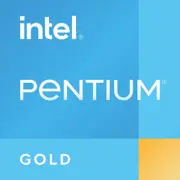Intel Pentium Gold G6600

Intel Pentium Gold G6600: Budget Processor for Basic Tasks in 2025
Introduction
Even in 2025, processors from previous generations remain relevant for budget builds. The Intel Pentium Gold G6600 is a prime example of such a solution. Despite the architecture's age, it continues to maintain demand thanks to its low price (around $60–70 for new units) and adequate performance for everyday tasks. Let's explore who this chip is suitable for and how to use it correctly.
Key Specifications: Architecture and Performance
Outdated, but Practical Process
The Pentium Gold G6600 is built on the Comet Lake architecture (10th generation Intel) using a 14nm process. By 2025, this is already considered a "dinosaur," as modern Intel and AMD processors utilize 7–10nm technology. However, the 14nm process hasn't hindered Intel from optimizing power consumption: the chip's TDP is 58W, making it suitable for compact systems.
Cores, Threads, and Cache
- 2 Cores / 4 Threads: Multitasking is limited, but Hyper-Threading assists in light scenarios (e.g., browser + office applications).
- Base Frequency of 4.2 GHz: High single-thread performance (Geekbench 6 Single-Core - 901 points) ensures quick responsiveness in basic tasks.
- L3 Cache of 4MB: The minimum for 2025, but sufficient for basic work.
Intel UHD 630 Graphics
The integrated graphics support 4K@60Hz through HDMI/DisplayPort, but are not suitable for gaming. In 2025, it will suffice for:
- Video playback (including streaming services in 4K).
- Office applications.
- Light gaming at 720p resolution (e.g., Minecraft or CS:GO on low settings).
Compatible Motherboards: Socket and Chipsets
LGA 1200 Socket
The processor requires motherboards with the LGA 1200 socket. By 2025, new boards for this socket are no longer being produced, but models available in the market include:
- H410 / B460 / H470 / Z490 (e.g., ASUS Prime H410M-K or MSI B460M-A Pro).
- Price: $50–100 for new units.
Selection Considerations
- H410 Chipset: The most budget-friendly option, but lacks overclocking and has limited PCIe 3.0 support.
- B460 / H470: Support for USB 3.2 Gen 2 and more PCIe lanes.
- Z490: Overkill for the Pentium, but allows for faster memory (up to 2933 MHz).
Tip: Look for boards with M.2 NVMe slots for SSDs to speed up the system. For example, the Gigabyte B460M DS3H AC with Wi-Fi and two M.2 slots.
Supported Memory: DDR4 and Its Configurations
Only DDR4
The Pentium Gold G6600 works with DDR4-2400/2666MHz (depending on the chipset). The maximum volume is 128GB, but for practical tasks, 8–16GB is sufficient.
Recommendations for 2025:
- 8GB DDR4-2666 (2x4GB) - the minimum for Windows 11 and browser usage.
- 16GB DDR4-2666 (2x8GB) - comfortable for working with multiple applications.
Example: The Patriot Signature Line 16GB (2x8GB) DDR4-2666 kit costs around $35–40.
Power Supply: Power Calculation
TDP 58W — Not a Problem
Even considering the motherboard, SSD, and a couple of fans, the system consumes no more than 100–120W. For a build without a dedicated graphics card, a power supply of 300–400W will suffice (e.g., be quiet! System Power 10 400W for $45).
If Adding a Graphics Card
- For a GPU like the NVIDIA GTX 1650 (TDP 75W), choose a PSU rated at 450–500W.
- Example: EVGA 500 BR (500W, 80+ Bronze) — $55.
Pros and Cons of the Processor
Strengths
- Price: One of the cheapest new processors in 2025.
- Energy Efficiency: Suitable for mini-PCs and office builds.
- Integrated Graphics: Does not require a separate graphics card for basic tasks.
Weaknesses
- 2 Cores: Multitasking is limited — heavy applications (Photoshop, video editors) will lag.
- Outdated Architecture: Lags behind modern budget chips like the Intel Core i3-13100F ($90) or AMD Ryzen 3 5300G ($100).
Use Cases
Office and Study
- Working with documents, browsers, Zoom.
- Example: A build based on G6600 + 8GB DDR4 + 256GB SSD is ideal for remote work.
Multimedia
- Media center on TV: 4K video, streaming Netflix.
- Example: Mini-PC in a Silverstone ML05 case with passive cooling.
Light Gaming
- Games from before 2015: GTA V on low settings (720p, 30–40 FPS).
- Indie projects: Stardew Valley, Hollow Knight.
Comparison with Competitors
Intel vs AMD
- AMD Athlon 3000G (2 cores/4 threads, Vega 3): Cheaper ($45), but weaker in single-thread tasks (Geekbench 6 Single-Core - ~750).
- Intel Core i3-10100 (4 cores/8 threads): Costs $70–80 on the second-hand market, but offers +50% multi-threaded performance.
Conclusion: The G6600 only wins in a strict budget under $70. In other cases, it's better to invest a bit more in an i3 or Ryzen 3.
Practical Assembly Tips
1. Don't Skimp on SSD: Kingston A400 480GB ($30) will speed up system boot times.
2. Choose a Compact Case: For example, Fractal Design Core 500 ($60) for a media center.
3. Cooling: The boxed cooler is sufficient, but for quieter operation, consider the DeepCool GAMMAXX 400 V2 ($20).
Final Conclusion: Who Should Consider the Pentium Gold G6600?
This processor is a choice for those who:
- Are building a PC for office work, study, or home theater.
- Have a budget of $200–300 for the entire build.
- Do not plan to run modern games or "heavy" programs.
Alternative: If your budget allows an extra $30–40, consider the Intel Core i3-12100 or AMD Ryzen 3 5300U — they will provide a performance buffer for the future.
Value of the Pentium Gold G6600 in 2025 — lies in its simplicity and accessibility. It may not impress with its specifications, but it performs its role honestly in basic scenarios.
Basic
CPU Specifications
Memory Specifications
GPU Specifications
Miscellaneous
Benchmarks
Compared to Other CPU
Share in social media
Or Link To Us
<a href="https://cputronic.com/en/cpu/intel-pentium-gold-g6600" target="_blank">Intel Pentium Gold G6600</a>